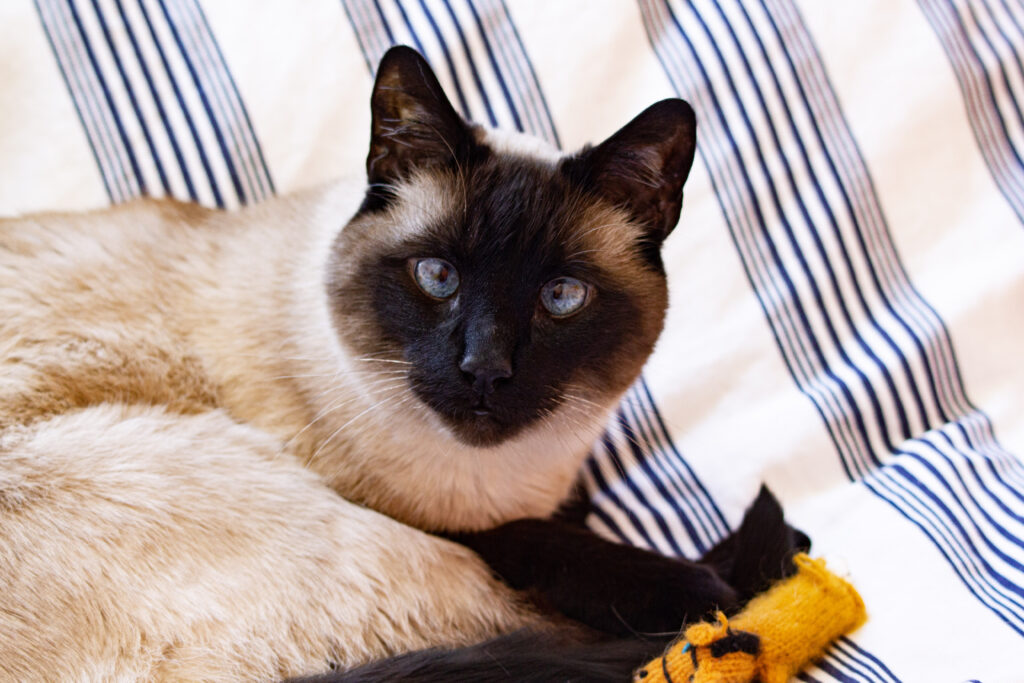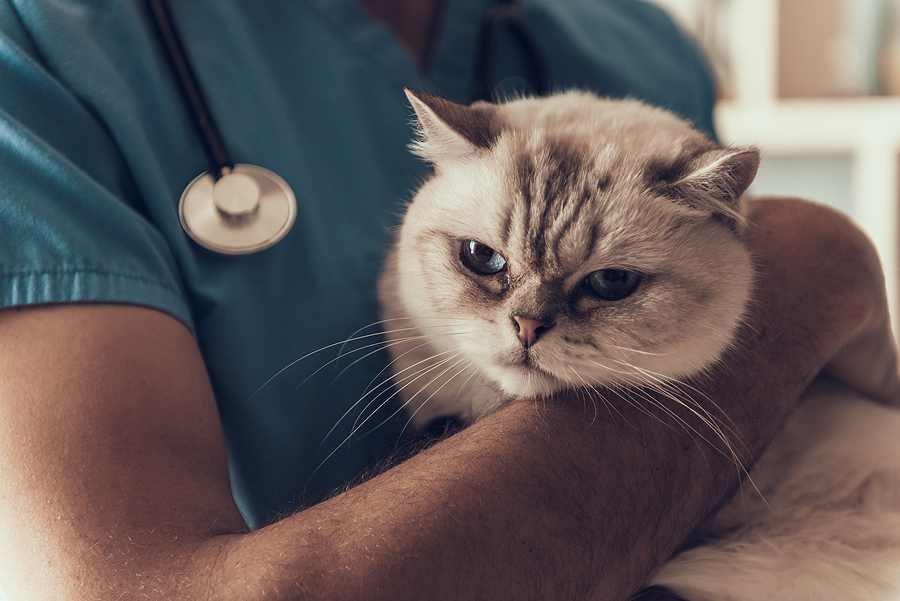Osteoarthritis affects more than 60 percent of cats six years and older, according to a recent study on the prevalence and clinical features of OA. Further, this painful condition isn’t exclusive to adult cats; felines as young as two years old can suffer from this debilitating disease, too. That’s eye-opening!
To make it worse, pet parents may fail to recognize the problem, attributing the fact that their cat isn’t jumping and has decreased mobility to “just slowing down with age.” Here’s what to look for and how to help relieve the pain and stress that OA causes to your cat’s general demeanor.
Osteoarthritis is underdiagnosed in cats, primarily because they are expert at hiding their pain both at home and at the veterinary clinic. According to a report published by Zoetis Petcare, only 13 percent of affected cats globally have been properly diagnosed. As a pet parent, you can take charge of the situation by monitoring your cat at home, keeping a checklist of behaviors, and discussing this issue at your pet’s wellness check. This can prompt an x-ray screening and early identification of OA. It also helps to establish a baseline of “normal” for that cat, which can go a long way in helping her as she ages into her teens.
What is Osteoarthritis and How Does It Differ From Rheumatoid Arthritis?
“Osteoarthritis is degenerative disease of the joint most commonly caused by wear and tear, injury, and aging,” says Mike Petty, DVM, certified veterinary pain practitioner and past president of the International Veterinary Academy of Pain Management. “As the tissue in the cat’s joints start to get wear down, it causes bones to rub against one another, causing severe pain and greatly hindering mobility. Rheumatoid arthritis is mainly a human disease caused by an autoimmune issue where the body develops antibodies against structures within the joint causing pain and arthritis.”
Key Signs of a Problem
“Dogs will limp; cats don’t, except for acute injuries,” Dr. Petty says. “Instead, it’s behavioral changes that are key to knowing something is wrong.”
Here are Petty’s telltale indicators:
- The litter box: Suddenly not using the box can be a behavioral issue or bladder problem but in many cases for a cat with joint issues, the sides of the box are too high to climb in, or it’s too painful to walk across the litter. While cats with OA may eliminate anywhere, most often it’s within the immediate vicinity of the box; they know they should use it but they cannot.
- Jumping. Suddenly they don’t like to sit on their favorite windowsill or furniture, or they hesitate to jump or use another lower piece of furniture to get there. And jumping down may present the same scenario.
- Stairs: Going up or down one step at a time.
- Play: They want to but are not as exuberant as they once were.
- Movement: They lose the grace and fluidity of a normal cat.
- The 3D space: Cats like to go to high spaces. As cats develop pain from OA, their world becomes less vertical and more horizontal.
Establishing Your Cat’s Baseline
A baseline is a reference point for what’s normal for your cat. Your veterinarian uses bloodwork, urinalysis, weight, and other factors determined at your cat’s annual visit to establish a baseline for his or her health. You can contribute to that baseline by being aware of your cat’s normal lifestyle and behaviors, says Joyce A. Login, DVM, CPH, veterinary medical lead, feline pain, with Zoetis Petcare. It may seem simple but it’s important. “Detecting a change is much easier with a baseline,” she says. “Even small variations in your cat’s ‘normal’ can indicate a potentially big problem.”
Elaborating on Petty’s key indicators, Dr. Login has the following helpful observations for pet parents. The negative changes in the first four of these behaviors (marked with an asterisk*) have been correlated with a clinical sign of osteoarthritis in cats that ultimately can lead to less energy and behavioral and even personality changes. Such changes should prompt a veterinary visit so your cat can be examined and diagnosed.
- Climbing up or down stairs.* Does your cat typically move in one fluid motion from top to bottom, take their time and carefully place their feet on each step, reflect along the way, or hesitate and move with effort, possibly stopping in a crouched position?
- Jumping up to or down from the counter.* Does your cat frequently jump up to the counter in a single leap or take smaller, part-way jumps, maybe pulling themselves up or reaching down first?
- Hunting or playing.* Does your cat engage in this activity every time you play or just occasionally? Does your cat keep up with the object or lag behind?
- Running.* Does your cat tend to run in bursts of energy or more when they’re startled? Does your cat run with a fast, fluid motion or move more slowly, perhaps alternating between a jog and a walk?
- Socializing. Is your cat a social butterfly or more reserved, preferring to have “alone time”? How do they act around visitors? How much time does your cat spend interacting with you and other family members (human or pet)?
- Grooming. How much time does your cat spend grooming? Are they able to bend in all directions or do they have difficulty reaching certain spots? Are they looking scruffy?
- Vocalizing. How talkative is your cat? Do they talk a lot or are they usually quiet?
- Eating. Does your cat have a big appetite or tend to be more finicky?
- Sleeping. Where does your cat typically like to sleep and how often do they sleep? Do they hunch up instead of curl up?
- How do they get up to stand and walk? Smoothly or slowly and stiffly?
- Is your cat suddenly withdrawn and appear to be hiding?
- The litter box. How frequently does your cat use the litter box? Does your cat miss the litter box?
You can find an animated checklist illustrating the difference between healthy cats and those with osteoarthritis at www.catoachecklist.com. The more information you can provide your cat’s veterinarian, the better. Take short videos, as actions speak louder than words to assist your veterinarian.
Pain Management and Changes Around the Home
“Pain management is exactly that, doing what you can to manage the situation to allow the cat to live a normal life,” says Petty. “Ramps or some kind of jumping block that allow cats to get to where they want to be are a plus. Cats will handle stairs between levels of the home at their own pace.”
Healthy Weight
It’s important for a cat parent to keep their cat at a healthy weight and encourage exercise, Petty says. “Keeping weight off house cats is not always easy. In the wild, they never know when the next meal is going to happen, so they are always hunting for their next meal. This instinct still happens in a domestic situation, too, only they keep heading to the food bowl. You can satisfy this instinct by picking a dozen places in the house to feed the cat and using two or three per day. Make your cat ‘hunt’ for kibble.”
Regenerative Treatments
Platelet-rich plasma injections are a type of regenerative therapy that Petty says can be helpful. PRP injections involve drawing tubes of the cat’s own blood and running it through a centrifuge to concentrate the platelets. These activated platelets are then injected directly into the injured or diseased body tissue. This releases growth factors that stimulate and increase the number of reparative cells the body produces.
“Sadly, this treatment is expensive and that’s the main reason why it’s not a common form of treatment,” he says.
Similarly, stem cell therapy is also an expensive option. To date, more such treatments have been done in dogs than in cats.
A New Medication Takes the Stage
A new medication called Solensia, which recently received FDA approval and is now available nationwide, is “a game changer,” Petty says. The injectable treatment is administered monthly at the veterinary clinic.
Petty participated in the FDA study used to approve this drug and says “It works amazingly well. It’s going to change the way we treat OA in cats.”
In fact, Petty’s “grandcat,” Alvin, was lucky to participate in the original Solensia trials. He was eight years old when he was adopted by Petty’s daughter Lauren.

“He was never a high-energy kitty, but he did love to be around people and got the occasional zoomies,” says his mom. “But when he was around 10 years old, I noticed that he no longer wanted to join us on the couch, which was so out of character. Luckily, my dad also noticed his behavior, examined him, ultimately diagnosing him with OA and getting him into the trial.
“Within two weeks of being on the medication, I already noticed a clear difference in his behavior. In fact, he was jumping from couch to couch, which he’d never done before and was also back to his usual snuggles with everyone. In hindsight, Alvin was probably already experiencing discomfort when I initially adopted him.”
In line with Lauren Petty’s observations of Alvin, a further three-month study done by Zoetis found that 77 percent of cat owners reported improvement in signs of pain when their cats were treated monthly with the injectable, improving their mobility, comfort, and general wellbeing.
How It Works
Solensia (frunevetmab injection) is a monoclonal antibody (mAb) therapy administered in the veterinary clinic. “Monoclonal antibodies are cloned populations of cells designed to remove and/or inactivate very specific targets that can cause infections or diseases. In this case, they target nerve growth factor (NGF) in the body, which is a key driver in OA pain,” Login says. “Solensia acts like a cat’s naturally made antibodies, binding to circulating NGF to reduce the amount available for pain signaling. This then leads to improving mobility, comfort, and overall wellbeing of cats.”
Petty says the drug has been available in Europe for some time and so far has not been shown to interfere with any other treatments a cat may be on for typical feline diseases such as kidney disease or diabetes. However, each cat’s individual case should be reviewed by their veterinarian.
Check with your veterinarian with regard to availability. Because the FDA has approved the drug, a spokesperson for Nationwide pet insurance confirmed “it would be covered by Nationwide as an eligible expense when appropriate coverage applies.” If you have pet insurance, check your policy.
This article was reviewed/edited by board-certified veterinary behaviorist Dr. Kenneth Martin and/or veterinary technician specialist in behavior Debbie Martin, LVT.








